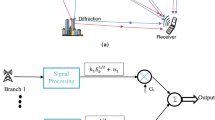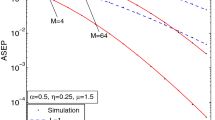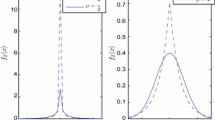Abstract
In this paper, we have analyzed the performance of maximal ratio combing (MRC) diversity receiver of the wireless communication systems over the composite fading environment, which is modelled by using the generalized-K distribution. However, this distribution has been considered as a versatile distribution for the precise modelling of a great variety of the short-term fading in conjunction with the long-term fading (shadow fading) channel conditions. In this proposed analysis, we have derived the mathematical expression for the moment generating function (MGF) of the generalized-K fading channel model that is used to evaluate a novel closed-form expression of the average bit error rate for (BER) the binary phase-shift keying /binary frequency-shift keying and average symbol error rate (SER) for the rectangular quadrature amplitude modulation scheme. We have also derived the mathematical expressions for the outage probability as well as the channel capacity for the generalized-K fading channel model.








Similar content being viewed by others
References
Simon, M. K., & Alouini, M.-S. (2005). Digital communication over fading channels (2nd ed.). New York: Wiley.
Dwivedi, V. K., & Singh, G. (2011). A novel moment generating function based performance analysis over correlated Nakagami-m fading. Journal of Computational Electronics, 10(4), 373–381.
Suzuki, H. (1977). A statistical model for urban radio propagation. IEEE Transactions on Communication, 25(7), 673–680.
Hansen, F., & Meno, F. I. (1977). Mobile fading-Rayleigh and Lognormal superimposed. IEEE Transactions on Vehicular Technology, 26(4), 332–335.
Shankar, P. M. (2004). Error rates in generalized shadowed fading channels. Wireless Personal Communications, 28(4), 233–238.
Abdi, A., & Kaveh, M. (1998). \(K\) distribution: An appropriate substitute for Rayleigh-Lognormal distribution in fading-shadow fading wireless channels. Electronics Letters, 34(9), 851–852.
Abdi, A., & Kaveh, M. (2000). Comparison of DPSK and MSK bit error rates for \(K\) and Rayleigh-Lognormal fading distributions. IEEE Communications Letters, 4(4), 122–124.
Shankar, P. M. (2006). Performance analysis of diversity combining algorithms in shadowed fading channels. Wireless Personal Communications, 37(1–2), 61–72.
Theofilakos, P., Kanatas, A. G., & Efthymoglou, G. P. (2008). Performance of generalized selection combining receivers in K fading channels. IEEE Communications Letters, 12, 816–818.
Bithas, P. S., Mathiopoulos, P. T., & Kotsopoulos, S. A. (2007). Diversity reception over generalized-K (K\(_{G})\) fading channels. IEEE Transactions on Wireless Communication, 6(12), 4238–4243.
Bithas, P. S., Sagias, N. C., Mathiopoulos, P. T., Karagiannidis, G. K., & Rontogiannis, A. A. (2006). On the performance analysis of digital communications over generalized-\(K\) fading channels. IEEE Communications Letters, 5(10), 353–355.
Laourine, A., Alouini, M.-S., Affes, S., & Stephenne, A. (2008). On the capacity of generalized-K fading channels. IEEE Transactions on Wireless Communications, 7(7), 2441–2445.
Efthymoglou, G. P., Ermolova, N. Y., & Aalo, V. A. (2010). Channel capacity and average error rates in generalized-K fading channels. IET Communications, 4(11), 1364–1372.
DiRenzo, M., Graziosi, F., & Santucci, F. (2010). Channel capacity over generalized fading channels: A novel MGF-based approach for performance analysis and design of wireless communication systems. IEEE Transactions on Vehicular Techology, 59, 127–149.
Gradshteyn, I. S., & Ryzhik, I. M. (2007). Table of integrals, series, and products (7th ed.). New York: Academic.
Prudnikov, A. P., Brychkov, Y. A., & Marichev, O. I. (1990). Integrals and series: More special functions. Gordon and Breach Science, vol. 3, translated from the Russian by G. G. Gould.
Dwivedi, V. K., & Singh, G. (2011). Error-rate analysis of the OFDM for correlated Nakagami-m fading channel by using maximal-ratio combining diversity. International Journal of Microwave and Wireless Technology, 3(6), 717–7263.
Simon, M. K., & Alouini, M.-S. (1999). A unified approach for calculating error rates of linearly modulated signals over generalized fading channels. IEEE Transactions on Communications, 47, 1324–1333.
Dwivedi, V. K., & Singh, G. (2012). Marginal moment generating function based analysis of channel capacity over correlated Nakagami-m fading with maximal-ratio combining diversity. Progress in Electromagnetic Research B, 41, 333–356.
Acknowledgments
The authors are sincerely thankful to the anonymous reviewers for their critical comments and suggestions to improve the quality of the manuscript.
Author information
Authors and Affiliations
Corresponding author
Appendices
Appendix: MGF of Generalized-K Fading Channel
Equation (4) can be obtained by substituting the value of \(f_\gamma (\gamma )\) from Eq. (2) into Eq. (3) and the MGF of generalized K-fading channel can be written as:
By putting \(K_\beta \left( {2\sqrt{\Xi \gamma }\cdot } \right) \) as \(\frac{1}{2}G{\small \begin{array}{ll} 2&{} 0 \\ 0&{} 2 \\ \end{array} }\left[ { {\Xi \gamma } \bigg |{\small \begin{array}{l} {\small {\begin{array}{ll} &{} \\ \end{array} }} \\ {\small {\begin{array}{cc} {\beta /2}&{} {{-\beta }/2} \\ \end{array} }} \\ \end{array} }} \right] \) [16, Equation (8.4.23.1)] in Eq. (20), we get:
By putting \(\int _0^\infty {x^{s-1}} e^{-\sigma {}x}G{\small \begin{array}{ll} m&{} n \\ p&{} q \\ \end{array} }\left[ {\omega {}x\left| {\small {\begin{array}{c} {\left( {a_p } \right) } \\ {\left( {b_q } \right) } \\ \end{array} }} \right. } \right] dx=\sigma ^{-s}G{\small \begin{array}{cc} m&{} {n+1} \\ {p+1}&{} q \\ \end{array} }\left[ { {\frac{\omega }{\sigma } } \bigg |{\small \begin{array}{ll} {\small {\begin{array}{cc} {1-s}&{} {\left( {a_p } \right) } \\ \end{array} }} \\ {\small {\begin{array}{cc} {\left( {b_q } \right) }&{} \\ \end{array} }} \\ \end{array} }} \right] \) form [16, Equation (2.24.3.1)] into Eq. (21) provides equation (4).
Appendix: Average BER for BPSK/BFSK Modulation Scheme
For the proof of Eq. (6), we assume, \(I_1 =\int _0^{\pi /2} {M_\gamma } \left( {\frac{g}{\sin ^{2}\theta }} \right) d\theta \) in Eq. (5). By using Eq. (4), \(I_{1}\) can be expressed as:
By changing the variable \(t=\sin ^{2}\theta \) and after some mathematical manipulation, Eq. (22) can be expressed as:
By using \(\int _0^1 {x^{s-1}} \left( {1-x} \right) ^{t-1}G{\small \begin{array}{ll} m&{} n \\ p&{} q \\ \end{array} }\left[ {\omega {}x\left| {{\small \begin{array}{cc} {\left( {a_p } \right) } \\ {\left( {b_q } \right) } \\ \end{array} }} \right. } \right] dx\!=\!\Gamma (t)G{\small \begin{array}{cc} m&{} {n\!+\!1} \\ {p\!+\!1}&{} {q\!+\!1} \\ \end{array} }\left[ {\omega \left| {{\small \begin{array}{cc} {{\small \begin{array}{cc} {1\!-\!s}&{} {\left( {a_p } \right) } \\ \end{array} }} \\ {{\small \begin{array}{cc} {\left( {b_q } \right) }&{} {1\!-\!s\!-\!t} \\ \end{array} }} \\ \end{array} }} \right. } \right] \) from [16, Equation (2.24.2)], the Eq. (23) can be expressed as:
By using Eqs. (5) and (24), we can obtain Eq. (6).
Appendix: Integration I\(_{3}\)
To derive Eq. (11), we proceed by using [15, Equation (6.643.3)] and Eq. (2), the MGF of the generalized K-fading distribution can be expressed as:
where \(W_{-\mu ,\nu } \left( \cdot \right) \) is the Whittaker function as discussed in [15, Equation (9.220.4)]. From Eq. (10) and (25), the integral \( I_{3}\) can be expressed as:
By using the transformation \(t = 2 \sin ^{2}\theta \) and after some mathematical manipulation, the Eq. (26) can be written as:
With the help of [15, Equation (9.220.4)], [15, Equation (9.220.3)] and [15, Equation (9.220.2)] Eq. (27) can be expressed as:
where, 1F\(_{1}\) is the confluent hpergeometric function as discussed in [15, Equation (9.210.1)]. By using [15, Equation (9.210.1)] and [15, Equation (9.111)], Eq. (28) can be written as Eq. (11).
Appendix: Outage Prabability
To derive Eq. (16), we proceed by substituting the value of \(f_\gamma (\gamma )\) from Eq. (2) into Eq. (15), \(P_{out}\) can be expressed as:
By replacing \(K_\beta \left( \cdot \right) \) as \(\frac{1}{2}G{\begin{array}{ll} 2&{} 0 \\ 0&{} 2 \\ \end{array} }\left[ { {\Xi \gamma } \bigg |{\begin{array}{cc} {{\begin{array}{cc} &{} \\ \end{array} }} \\ {{\begin{array}{cc} {\beta /2}&{} {{-\beta }/2} \\ \end{array} }} \\ \end{array} }} \right] \) from [16, Equation (8.4.23.1)] in Eq. (29), we get:
Now, with the help of \(\int _u^\infty {x^{s-1}} (x-u)^{t-1}G{\small \begin{array}{ll} m&{} n \\ p&{} q \\ \end{array} }\left[ {\omega {}x\left| {{\small \begin{array}{cc} {\left( {a_p } \right) } \\ {\left( {b_q } \right) } \\ \end{array} }} \right. } \right] dx=\Gamma (t) G{\small \begin{array}{cc} {m+1}&{} n \\ {p+1}&{} {q+1} \\ \end{array} } \left[ {\omega {}\left| {{\small \begin{array}{cc} {{\begin{array}{cc} {\left( {a_p } \right) }&{} {1-s} \\ \end{array} }} \\ {{\small \begin{array}{cc} {1-s-t}&{} {\left( {b_q } \right) } \\ \end{array} }} \\ \end{array} }} \right. } \right] \) from [16, Equation (2.24.2.3)], the Eq. (30) can be expressed as Eq. (16).
Appendix: Channel Capacity by Channel Inversion with Fixed Rate
To derive Eq. (19), we proceed by sssuming, \(I_6 =\int _0^\infty {M_\gamma } \left( s \right) ds\) in Eq. (18). Using Eq. (4) \(I_{6}\) can be expressed as:
By putting 1/s = t in Eq. (31) and using [15, Equation (7.811.4)], Eq. (31) can be written as:
If we substitute value of \(I_{6}\) from Eq. (32) to Eq. (18) it results Eq. (19).
Rights and permissions
About this article
Cite this article
Dwivedi, V.K., Singh, G. Moment Generating Function Based Performance Analysis of Maximal-Ratio Combining Diversity Receivers in the Generalized-K Fading Channels. Wireless Pers Commun 77, 1959–1975 (2014). https://doi.org/10.1007/s11277-014-1618-1
Published:
Issue Date:
DOI: https://doi.org/10.1007/s11277-014-1618-1




